The Design and Experimental Validation of a Biomimetic Stubble-Cutting Device Inspired by a Leaf-Cutting Ant’s Mandibles
Abstract
1. Introduction
2. Materials and Methods
2.1. Design of the BSCD
2.2. Soil Bin Tests
2.3. Field Experiments
3. Results and Discussion
3.1. Results of Soil Bin Tests
3.2. Results of Field Experiments
3.3. Discussion on the Mechanism of Drag Reduction and Energy Saving of the BSCD
4. Conclusions
- (1)
- The three operating parameters of rotational speed, tillage depth, and forward speed affect cutting torque and power consumption in the following order of magnitude: tillage depth, rotational speed, and forward speed. Taking the minimum torque and power as the target and considering the stubble-breaking effect, the optimal operating parameters determined by combining the response surface method are as follows: rotational speed = 240 rpm, plowing depth = 90 mm, and forward speed = 3 km·h−1.
- (2)
- The cutting torque and power of the BSCD were consistently lower than those of the TPSB under different RPM and forward speed operating conditions, with a reduction in cutting torque of 15.2–16.4% and a reduction in power of 9.2–11.3%.
- (3)
- The BSCD has a very good stubble-cutting performance; its best stubble-cutting rate can reach 97.4%, which is higher than the that of the TPSB.
- (4)
- The BSCD offers the advantages of low torque, low power consumption, and a high stubble-cutting rate. Its excellent operating performance is due to the multi-toothed structure of the cutting edge and the cutting mode.
Author Contributions
Funding
Institutional Review Board Statement
Data Availability Statement
Conflicts of Interest
References
- Obia, A.; Cornelissen, G.; Martinsen, V.; Smebye, A.B.; Mulder, J. Conservation tillage and biochar improve soil water content and moderate soil temperature in a tropical Acrisol. Soil Tillage Res. 2020, 197, 104521. [Google Scholar]
- Das, A.; Layek, J.; Idapuganti, R.G.; Basavaraj, S.; Lal, R.; Rangappa, K.; Yadav, G.S.; Babu, S.; Ngachan, S. Conservation tillage and residue management improves soil properties under a upland rice-rapeseed system in the subtropical eastern Himalayas. Land Degrad. Dev. 2020, 31, 1775–1791. [Google Scholar]
- Kovács, G.P.; Simon, B.; Balla, I.; Bozóki, B.; Dekemati, I.; Gyuricza, C.; Percze, A.; Birkás, M. Conservation Tillage Improves Soil Quality and Crop Yield in Hungary. Agronomy 2023, 13, 894. [Google Scholar]
- Diaz-Zorita, M.; Duarte, G.A.; Grove, J.H. A review of no-till systems and soil management for sustainable crop production in the subhumid and semiarid Pampas of Argentina. Soil Tillage Res. 2002, 65, 1–18. [Google Scholar]
- Zhu, H.; Zhao, H.; Bai, L.; Ma, S.; Zhang, X.; Li, H. Mechanical Characteristics of Rice Root-Soil Complex in Rice-Wheat Rotation Area. Agriculture 2022, 12, 1045. [Google Scholar] [CrossRef]
- Zhang, S.; Zhao, H.; Wang, X.; Dong, J.; Zhao, P.; Yang, F.; Chen, X.; Liu, F.; Huang, Y. Discrete element modeling and shear properties of the maize stubble-soil complex. Comput. Electron. Agric. 2023, 204, 107519. [Google Scholar] [CrossRef]
- Boldrin, D.; Leung, A.K.; Bengough, A.G. Root biomechanical properties during establishment of woody perennials. Ecol. Eng. 2017, 109, 196–206. [Google Scholar] [CrossRef]
- Mickovski, S.B.; Ennos, R.A. Anchorage and asymmetry in the root system of Pinus peuce. Silva Fenn. 2003, 37, 161–173. [Google Scholar] [CrossRef][Green Version]
- Mickovski, S.B.; Ennos, R.A. A morphological and mechanical study of the root systems of suppressed crown Scots pine Pinus sylvestris. Trees 2002, 16, 274–280. [Google Scholar] [CrossRef]
- Jiang, J.L.; Gong, L.N.; Wang, D.W.; Wang, G.P. Development and experiment for driving double coulters anti-blockage device of no-till planter. Trans. Chin. Soc. Agric. Eng. 2012, 28, 17–22. (In Chinese) [Google Scholar]
- Honglei, J.; Xinming, J.; Hongfang, Y.; Jian, Z.; Jiale, Z.; Mingzhuo, G. Stalk cutting mechanism of no-tillage planter for wide/narrow row farming mode. Int. J. Agric. Biol. Eng. 2017, 10, 26–35. [Google Scholar]
- Zhu, H.; He, X.; Shang, S.; Zhao, Z.; Wang, H.; Tan, Y.; Li, C.; Wang, D. Evaluation of Soil-Cutting and Plant-Crushing Performance of Rotary Blades with Double-Eccentric Circular-Edge Curve for Harvesting Cyperus esculentus. Agriculture 2022, 12, 862. [Google Scholar] [CrossRef]
- Quan, L.; Tong, J.; Zeng, B.; Chen, D. Optimization design of sliding cutting edge curve of corn rootstalk cutting tool. Trans. Chin. Soc. Agric. Eng. 2011, 27, 13–17. (In Chinese) [Google Scholar]
- Ren, L.-Q.; Tong, J.; Li, J.-Q.; Chen, B.-C. Soil adhesion and biomimetics of soil-engaging components: A review. J. Agric. Eng. Res. 2001, 79, 239–263. [Google Scholar]
- Torotwa, I.; Ding, Q.; Makange, N.R.; Liang, L.; He, R. Performance evaluation of a biomimetically designed disc for dense-straw mulched conservation tillage. Soil Tillage Res. 2021, 212, 105068. [Google Scholar]
- Zhang, Z.J.; Jia, H.L.; Sun, J.Y. Review of application of biomimetics for designing soil-engaging tillage implements in Northeast China. Int. J. Agric. Biol. Eng. 2016, 9, 12–21. [Google Scholar]
- Zhu, H.; Wu, X.; Qian, C.; Bai, L.; Ma, S.; Zhao, H.; Zhang, X.; Li, H. Design and Experimental Study of a Bi-Directional Rotating Stubble-Cutting No-Tillage Planter. Agriculture 2022, 12, 1637. [Google Scholar]
- Zhao, J.L.; Lu, Y.; Guo, M.Z.; Fu, J.; Wang, Y.J. Design and experiment of bionic stubble breaking-deep loosening combined tillage machine. Int. J. Agric. Biol. Eng. 2021, 14, 123–134. [Google Scholar] [CrossRef]
- Chang, Z.; Liu, W.; Tong, J.; Guo, L.; Xie, H.; Yang, X.; Mu, H.; Chen, D. Design and Experiments of Biomimetic Stubble Cutter. J. Bionic Eng. 2016, 13, 335–343. [Google Scholar] [CrossRef]
- Qu, Y.; Pan, C.L.; Guo, H.P. Factors Affecting the Promotion of Conservation Tillage in Black Soil-The Case of Northeast China. Sustainability 2021, 13, 9563. [Google Scholar] [CrossRef]
- Zhao, J.; Wang, X.; Zhuang, J.; Liu, H.; Wang, Y.; Yu, Y. Coupled Bionic Design Based on Primnoa Mouthpart to Improve the Performance of a Straw Returning Machine. Agriculture 2021, 11, 775. [Google Scholar] [CrossRef]
- Elizalde, L.; Folgarait, P.J. Biological attributes of Argentinian phorid parasitoids (Insecta: Diptera: Phoridae) of leaf-cutting ants, Acromyrmex and Atta. J. Nat. Hist. 2011, 45, 2701–2723. [Google Scholar] [CrossRef]
- Swanson, A.C.; Schwendenmann, L.; Allen, M.F.; Aronson, E.L.; Artavia-León, A.; Dierick, D.; Fernandez-Bou, A.S.; Harmon, T.C.; Murillo-Cruz, C.; Oberbauer, S.F.; et al. Welcome to the Atta world: A framework for understanding the effects of leaf-cutter ants on ecosystem functions. Funct. Ecol. 2019, 33, 1386–1399. [Google Scholar]
- Stephan, J.G.; Wirth, R.; Leal, I.R.; Meyer, S.T. Spatially Heterogeneous Nest-Clearing Behavior Coincides with Rain Event in the Leaf-Cutting Ant Atta cephalotes (L.) (Hymenoptera: Formicidae). Neotrop. Entomol. 2015, 44, 123–128. [Google Scholar] [CrossRef] [PubMed]
- Li, H.; Sun, C.Y.; Fang, Y.; Carlson, C.M.; Xu, H.; Ješovnik, A.; Sosa-Calvo, J.; Zarnowski, R.; Bechtel, H.A.; Fournelle, J.H.; et al. Biomineral armor in leaf-cutter ants. Nat. Commun. 2020, 11, 5792. [Google Scholar]
- Tautz, J.; Roces, F.; Hölldobler, B. Use of a sound-based vibratome by leaf-cutting ants. Science 1995, 267, 84–87. [Google Scholar] [CrossRef]
- Yao, G.; Feng, L.; Zhang, D.; Jiang, X. Morphology and Mechanical Properties of Vibratory Organs in the Leaf-cutting Ant (Atta cephalotes). J. Bionic Eng. 2018, 15, 722–730. [Google Scholar] [CrossRef]
- Paul, J. Mandible movements in ants. Comp. Biochem. Physiol. A Mol. Integr. Physiol. 2001, 131, 7–20. [Google Scholar] [PubMed]
- da Silva Camargo, R.; Silva, L.; Forti, L.C.; Lopes, J.F. Mandibles of Leaf-Cutting Ants: Morphology Related to Food Preference. Sociobiology 2016, 63, 881–888. [Google Scholar] [CrossRef]
- Pielstrom, S.; Roces, F. Vibrational communication in the spatial organization of collective digging in the leaf-cutting ant Atta vollenweideri. Anim. Behav. 2012, 84, 743–752. [Google Scholar]
- Pueffel, F.; Johnston, R.; Labonte, D. A biomechanical model for the relation between bite force and mandibular opening angle in arthropods. Roy Soc. Open Sci. 2023, 10, 221066. [Google Scholar] [CrossRef] [PubMed]
- Püffel, F.; Pouget, A.; Liu, X.; Zuber, M.; van de Kamp, T.; Roces, F.; Labonte, D. Morphological determinants of bite force capacity in insects: A biomechanical analysis of polymorphic leaf-cutter ants. J. R Soc. Interface 2021, 18, 20210424. [Google Scholar] [CrossRef] [PubMed]
- Stark, A.Y.; Davis, H.R.; Harrison, W.K. Shear adhesive performance of leaf-cutting ant workers (Atta cephalotes). Biotropica 2019, 51, 572–580. [Google Scholar] [CrossRef]
- Matin, M.A.; Fielke, J.M.; Desbiolles, J.M.A. Torque and energy characteristics for strip-tillage cultivation when cutting furrows using three designs of rotary blade. Biosyst. Eng. 2015, 129, 329–340. [Google Scholar] [CrossRef]
- Yang, Y.; Fielke, J.; Ding, Q.; He, R. Field experimental study on optimal design of the rotary strip-till tools applied in rice-wheat rotation cropping system. Int. J. Agric. Biol. Eng. 2018, 11, 88–94. [Google Scholar] [CrossRef]
- Yang, Y.; Tong, J.; Huang, Y.; Li, J.; Jiang, X. Biomimetic Rotary Tillage Blade Design for Reduced Torque and Energy Requirement. Appl. Bionics Biomech. 2021, 2021, 8573897. [Google Scholar] [CrossRef] [PubMed]
- Salokhe, V.; Miah, M.H.; Hoki, M. Effect of blade type on power requirement and puddling quality of a rotavator in wet clay soil. J. Terramech. 1993, 30, 337–350. [Google Scholar] [CrossRef]
- Tong, J.; Ji, W.; Jia, H.; Chen, D.; Yang, X. Design and Tests of Biomimetic Blades for Soil-rototilling and Stubble-breaking. J. Bionic Eng. 2015, 12, 495–503. [Google Scholar] [CrossRef]
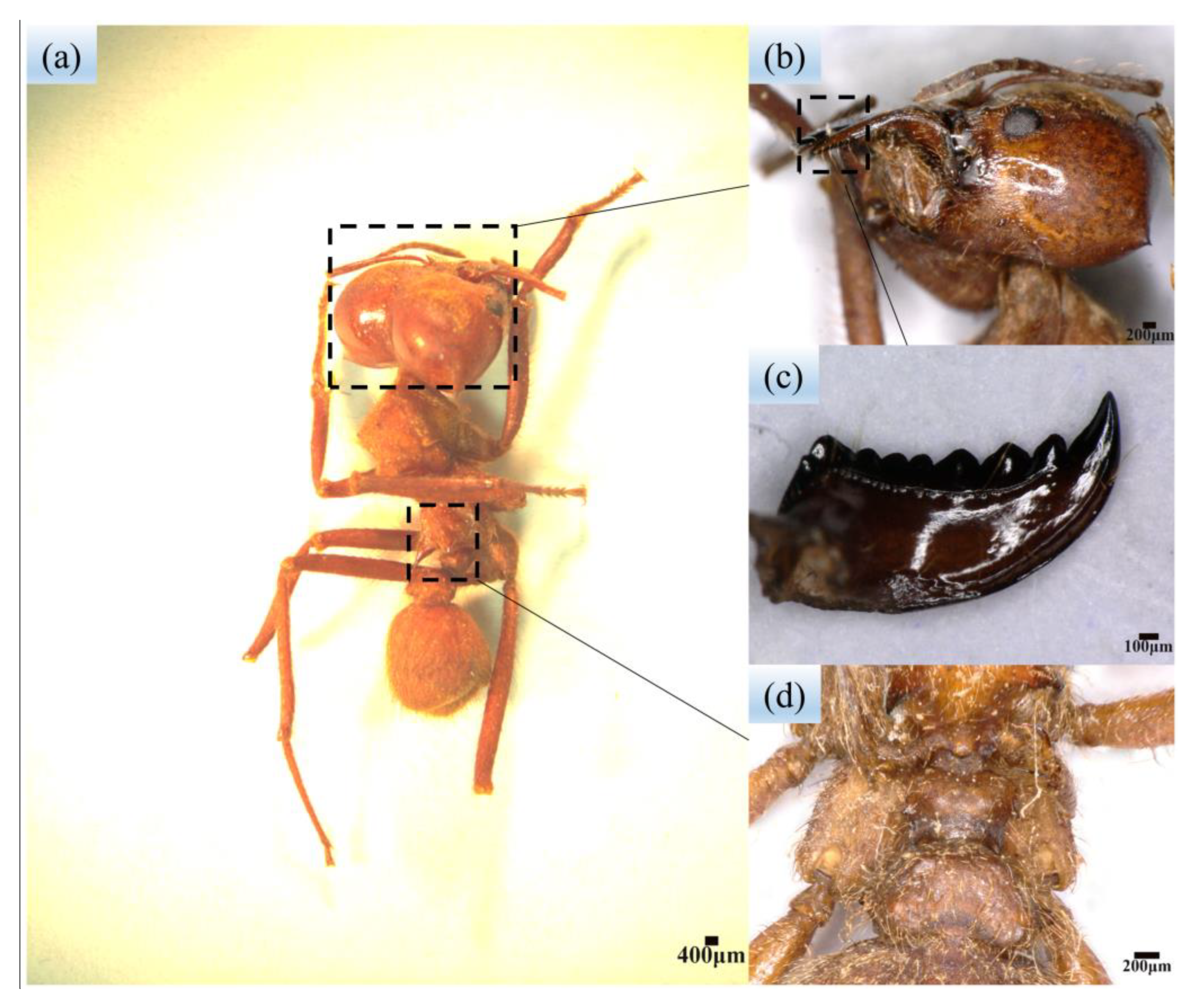

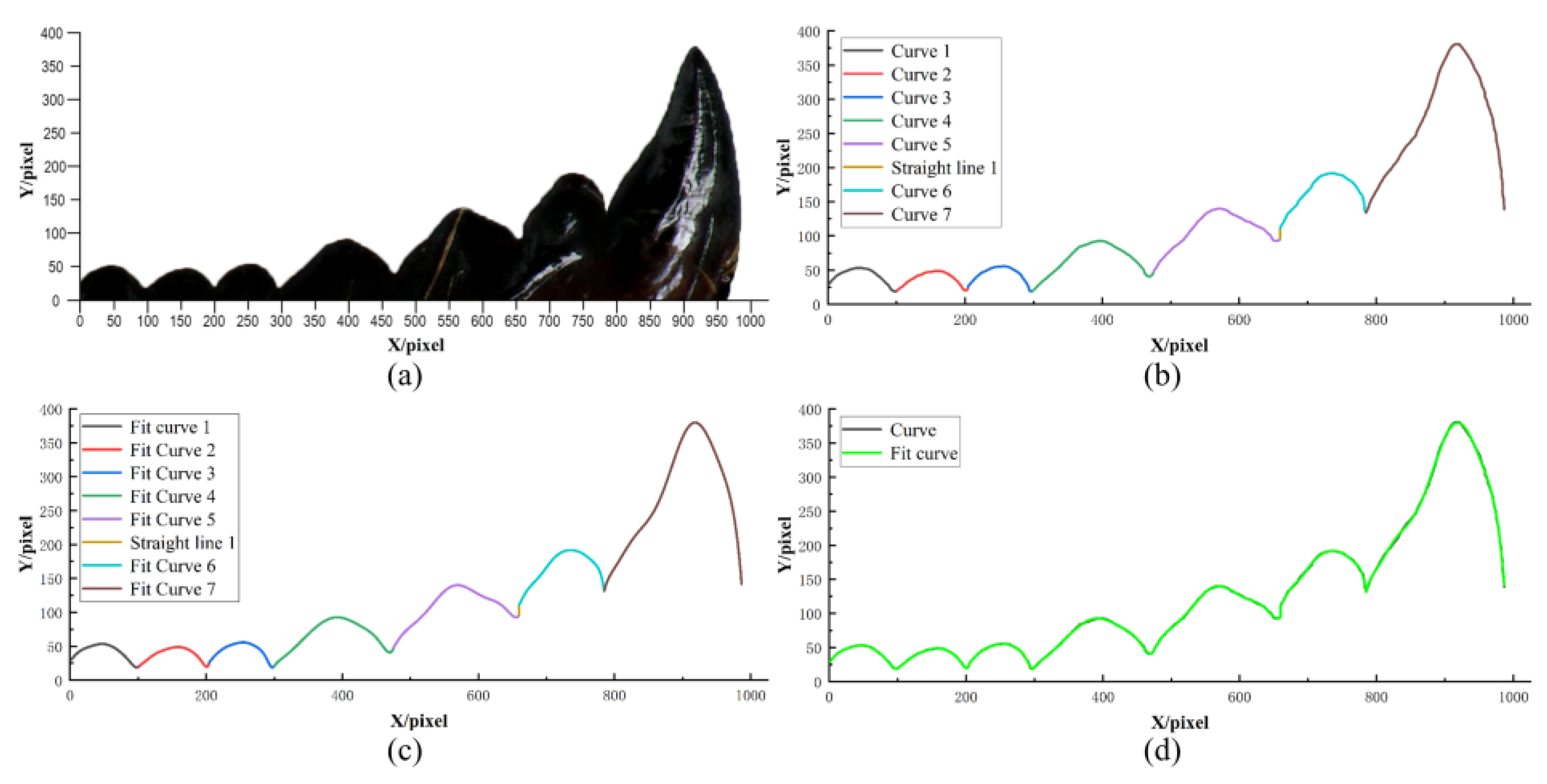
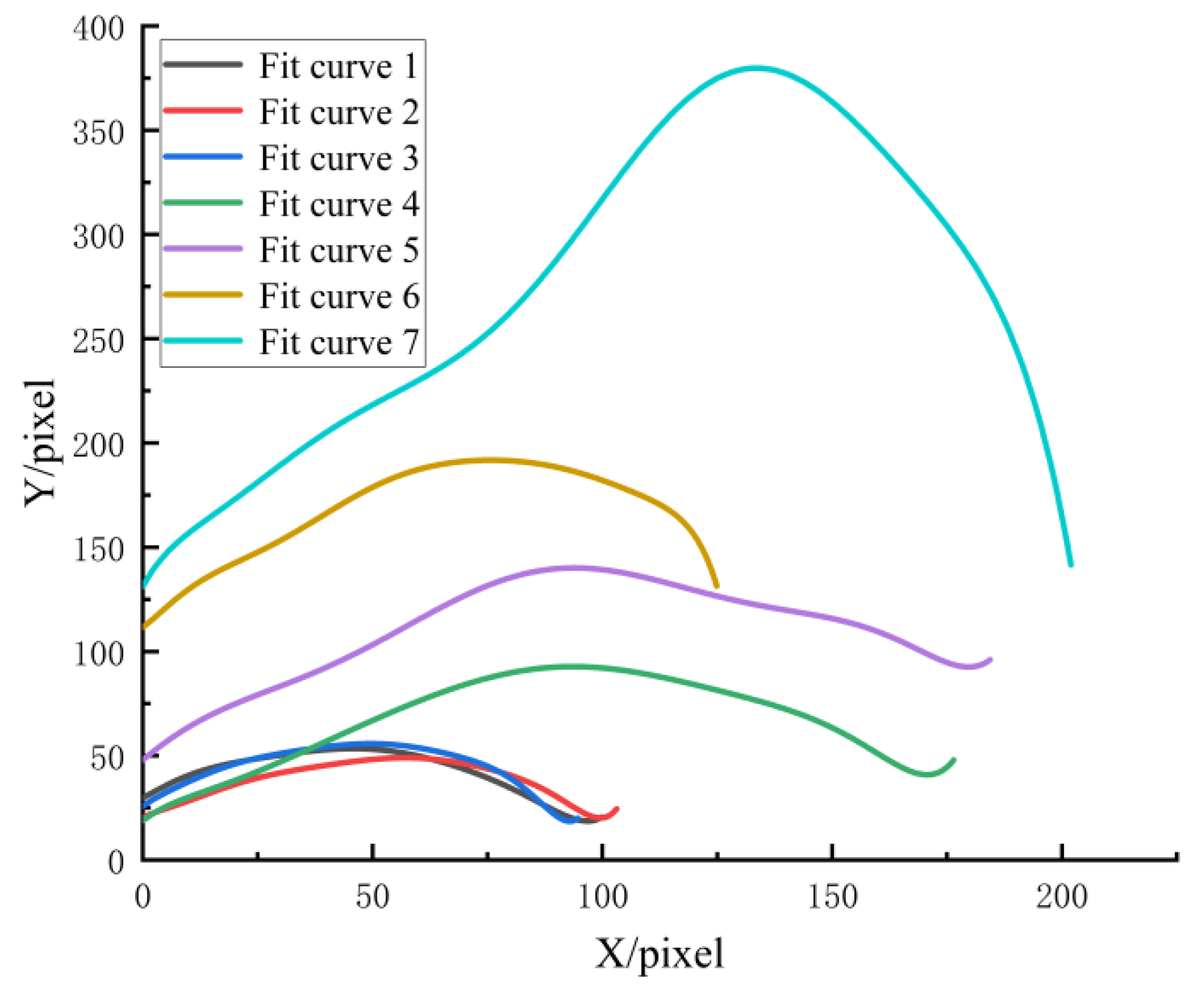
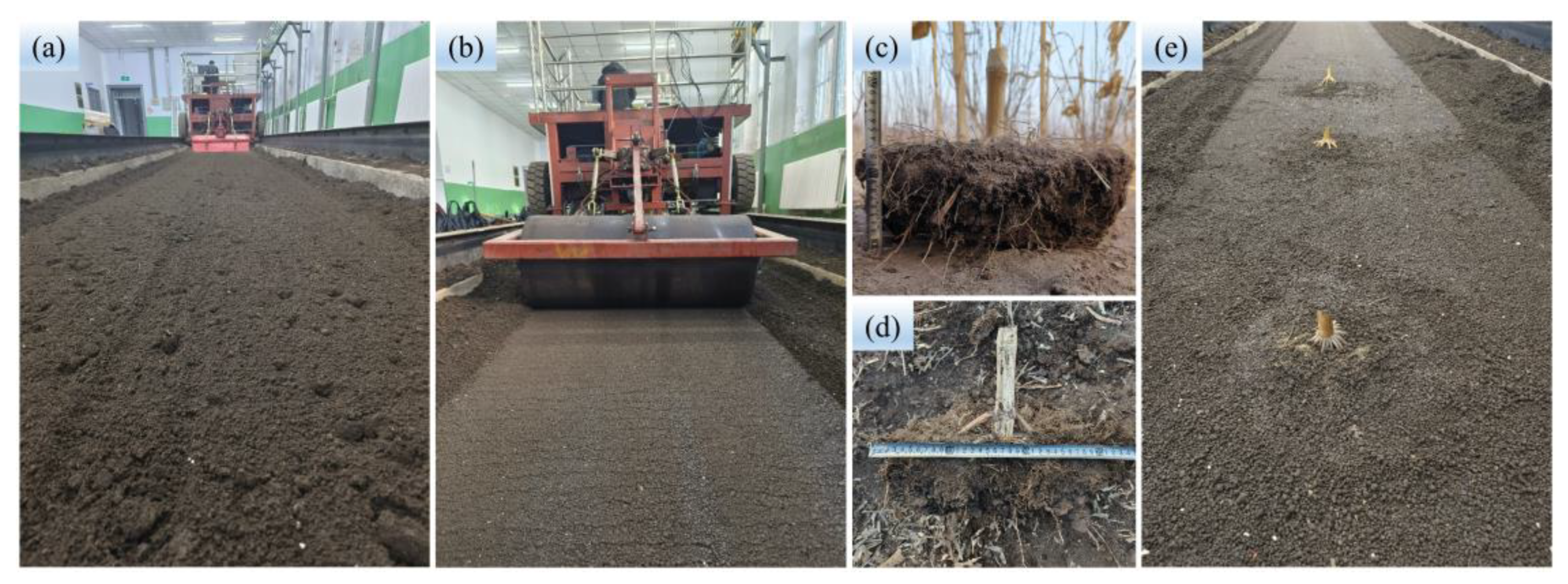

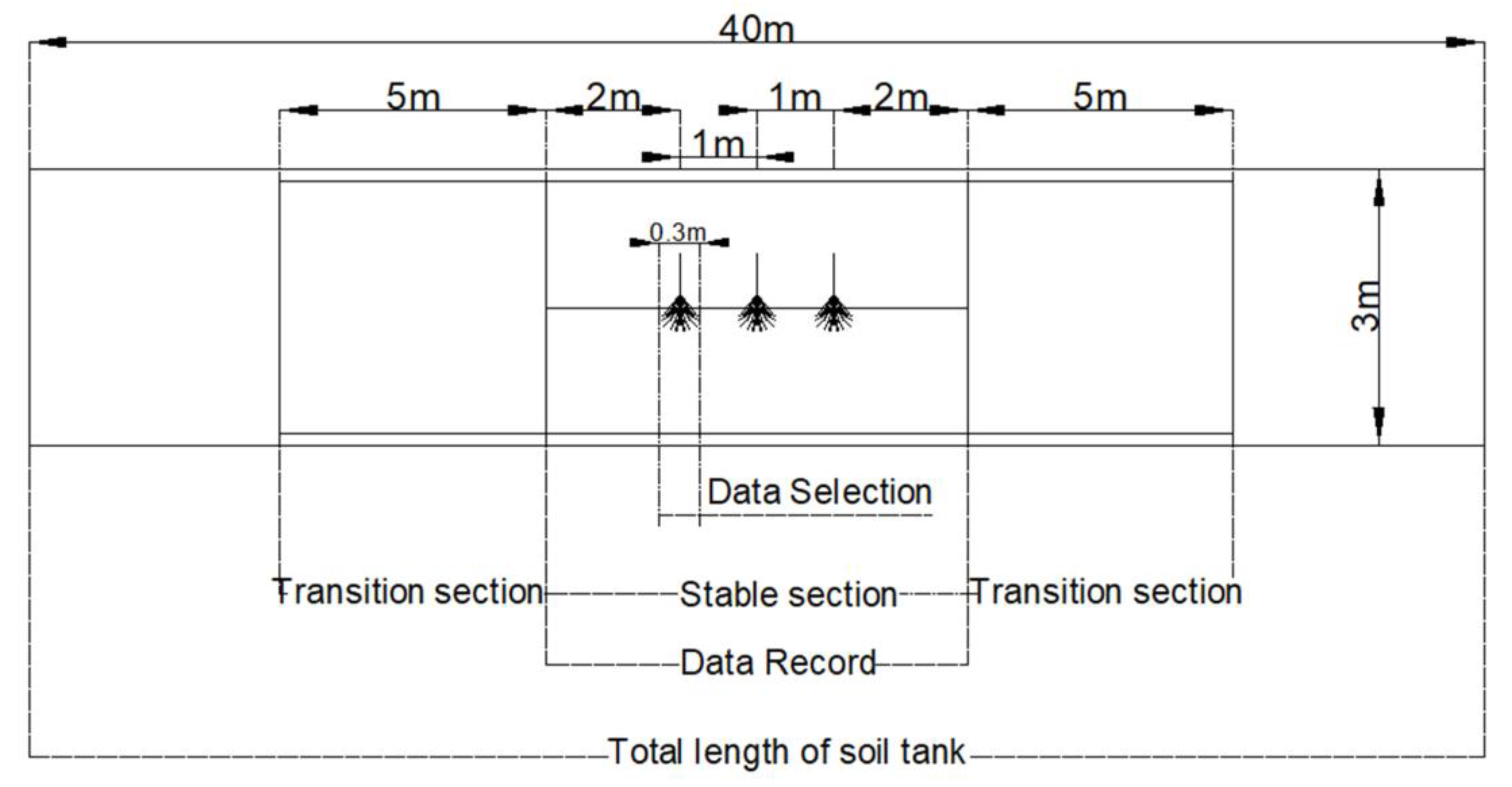
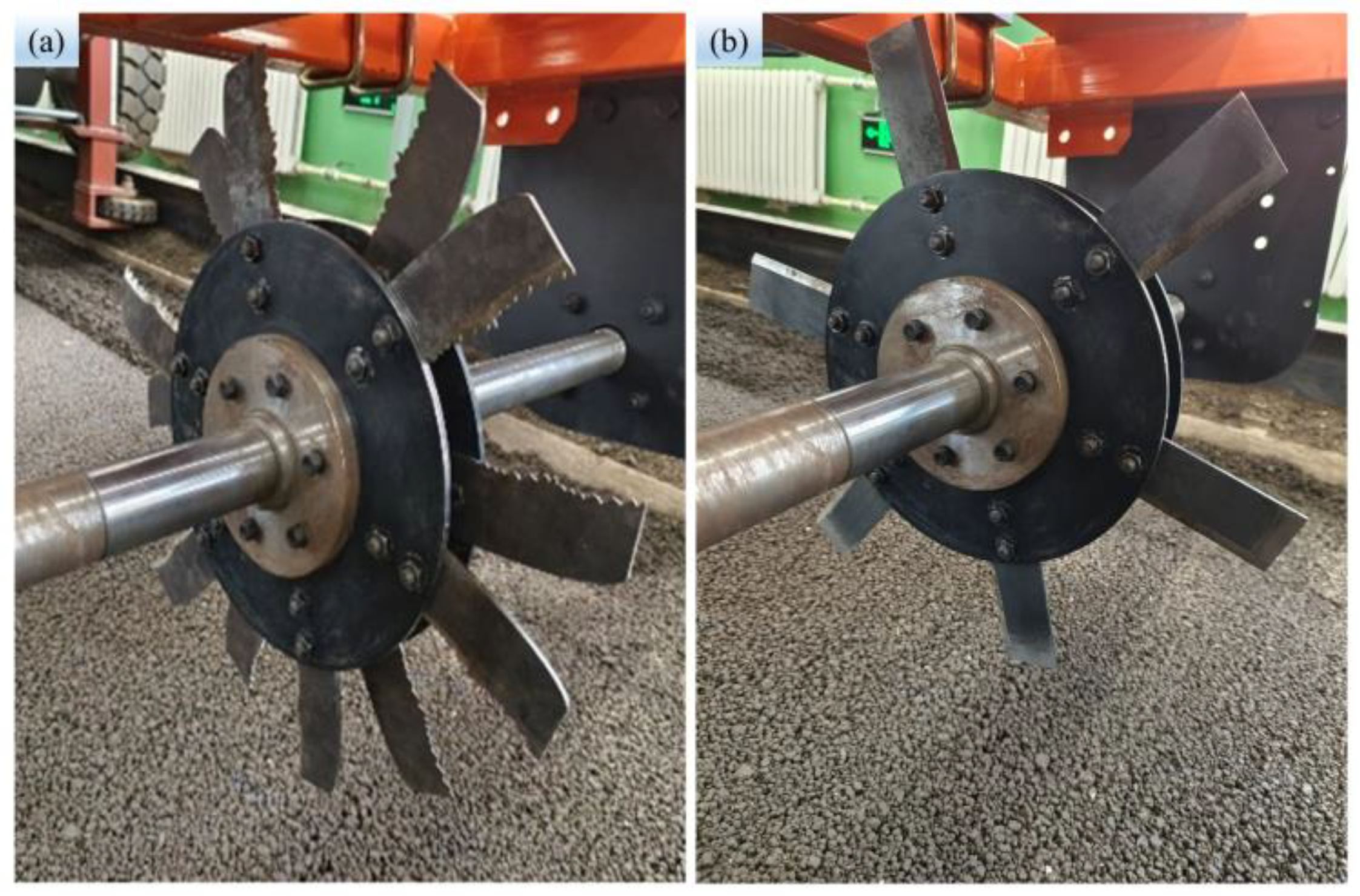
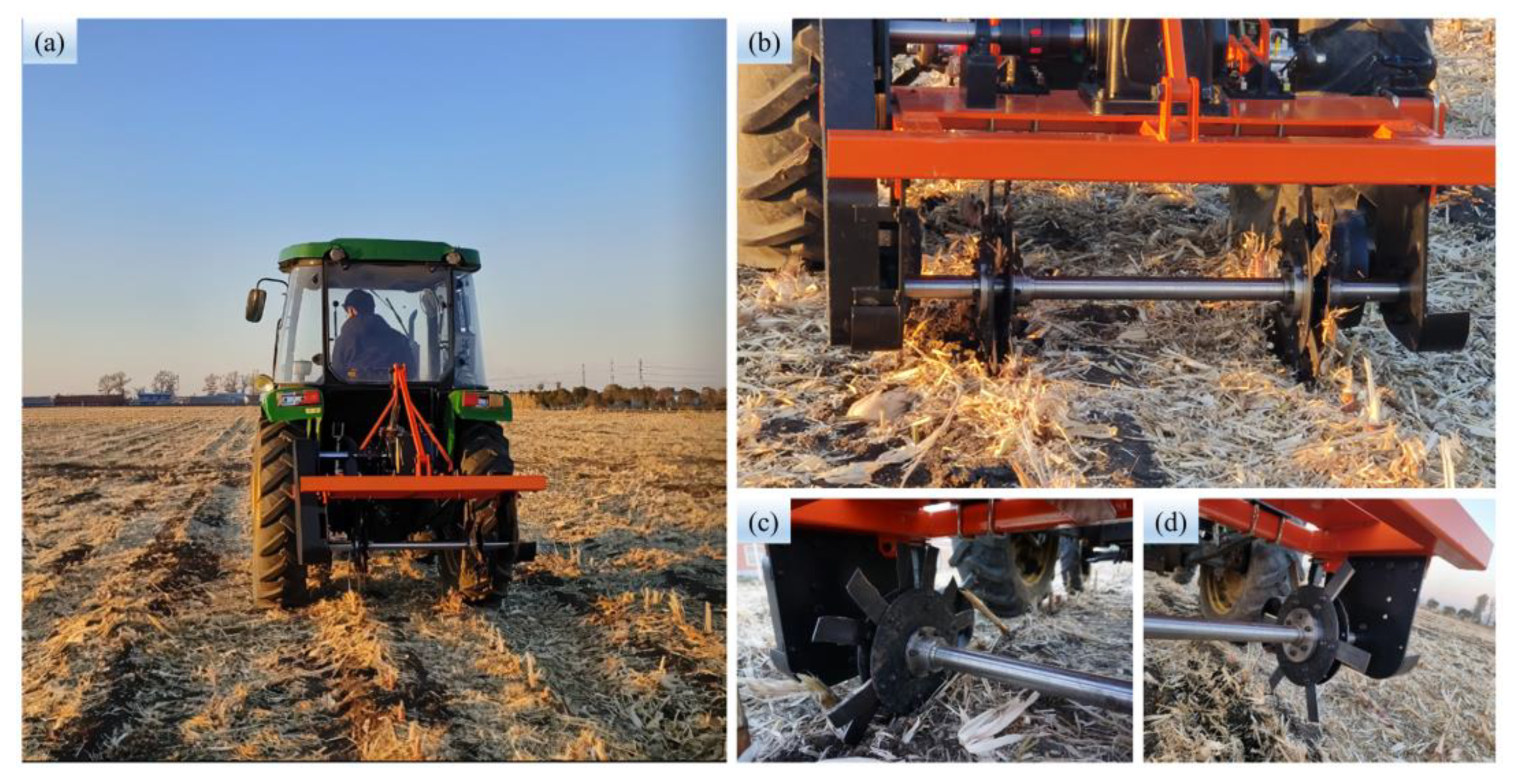


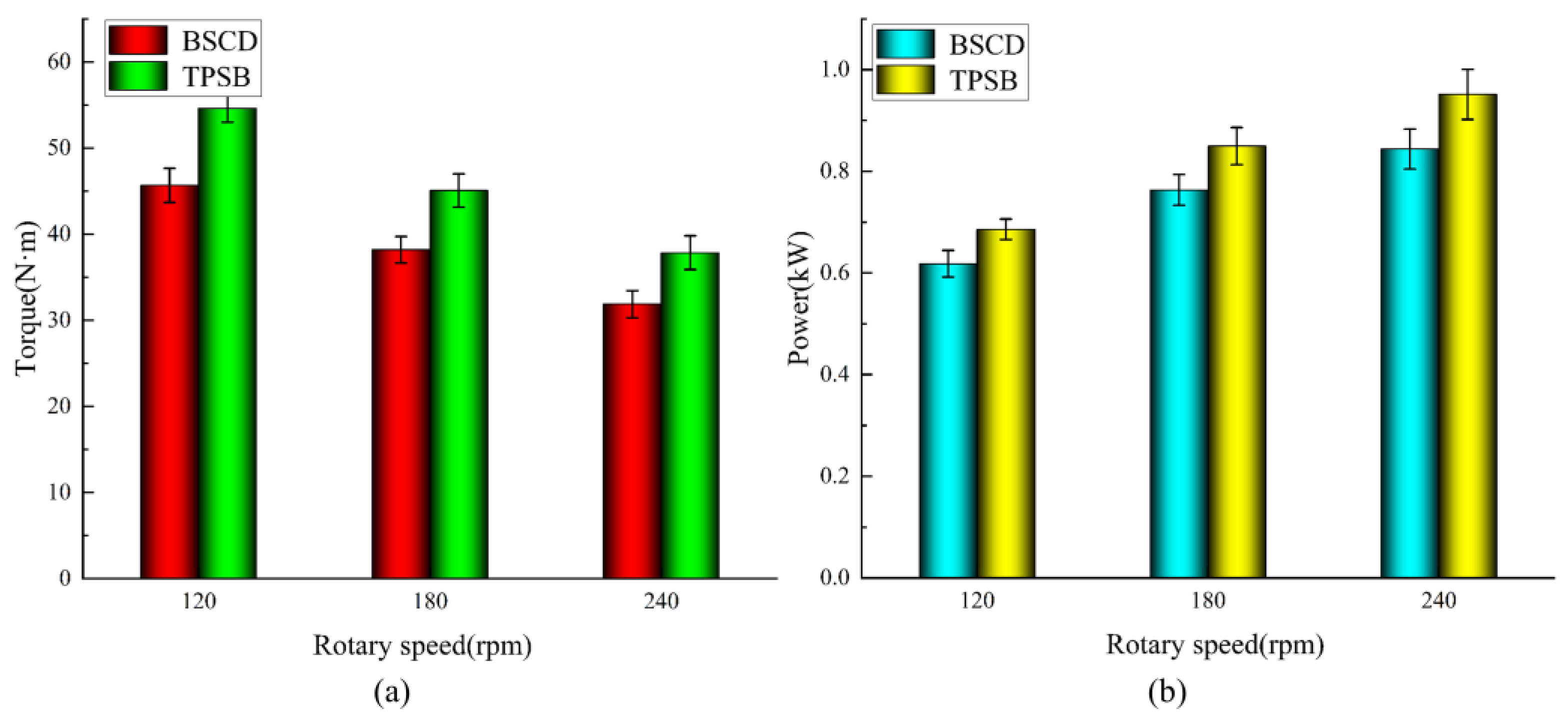
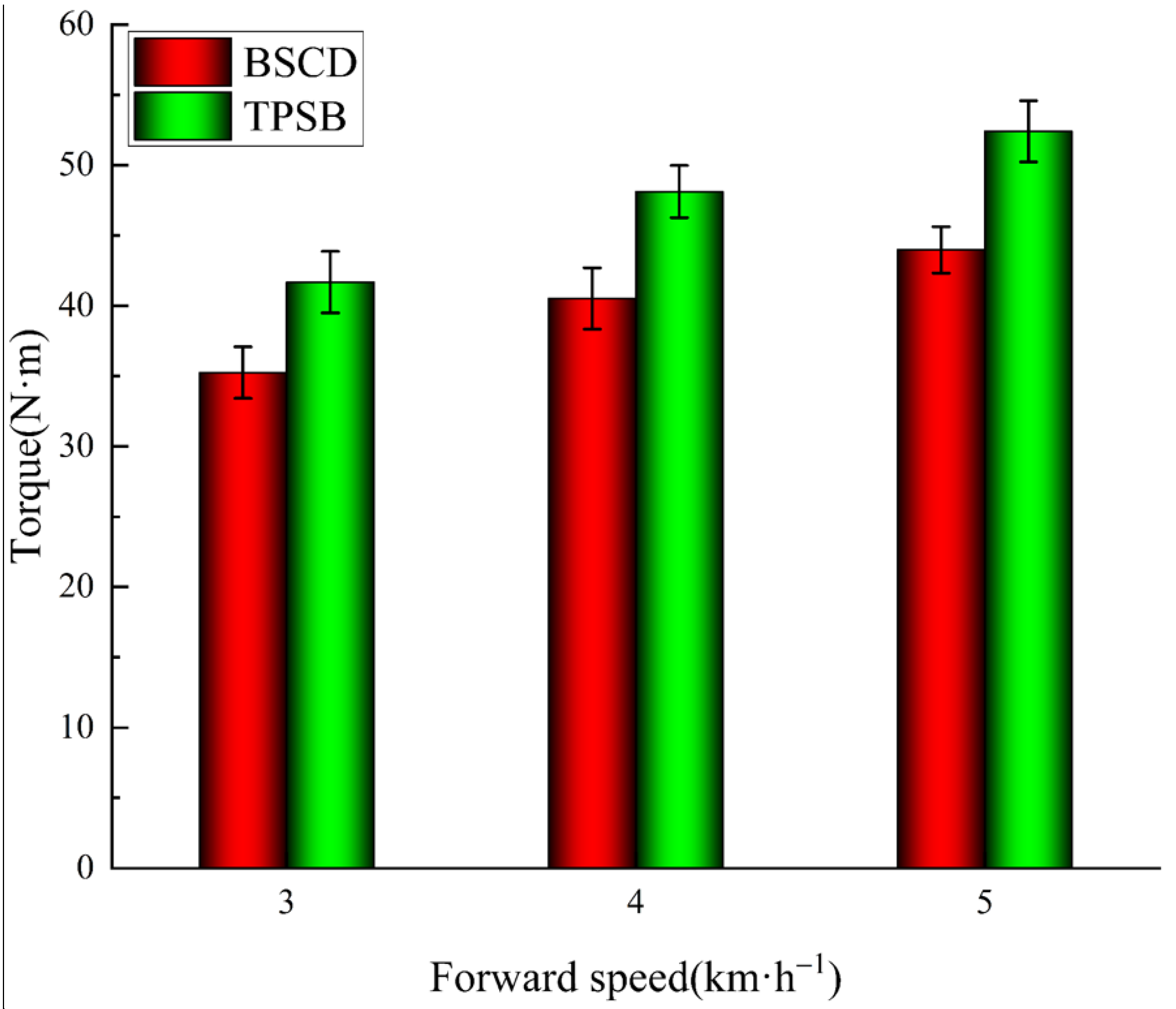
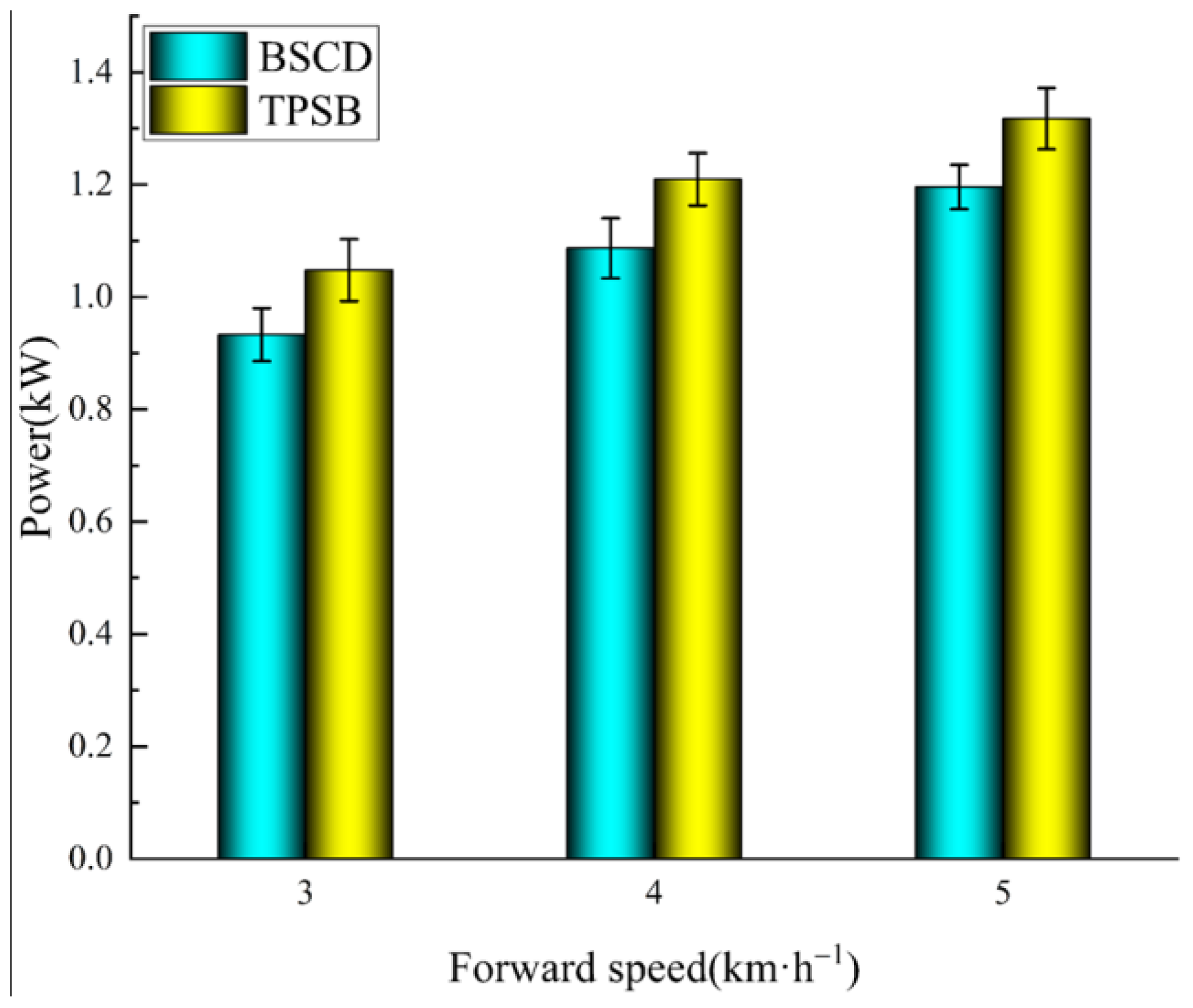
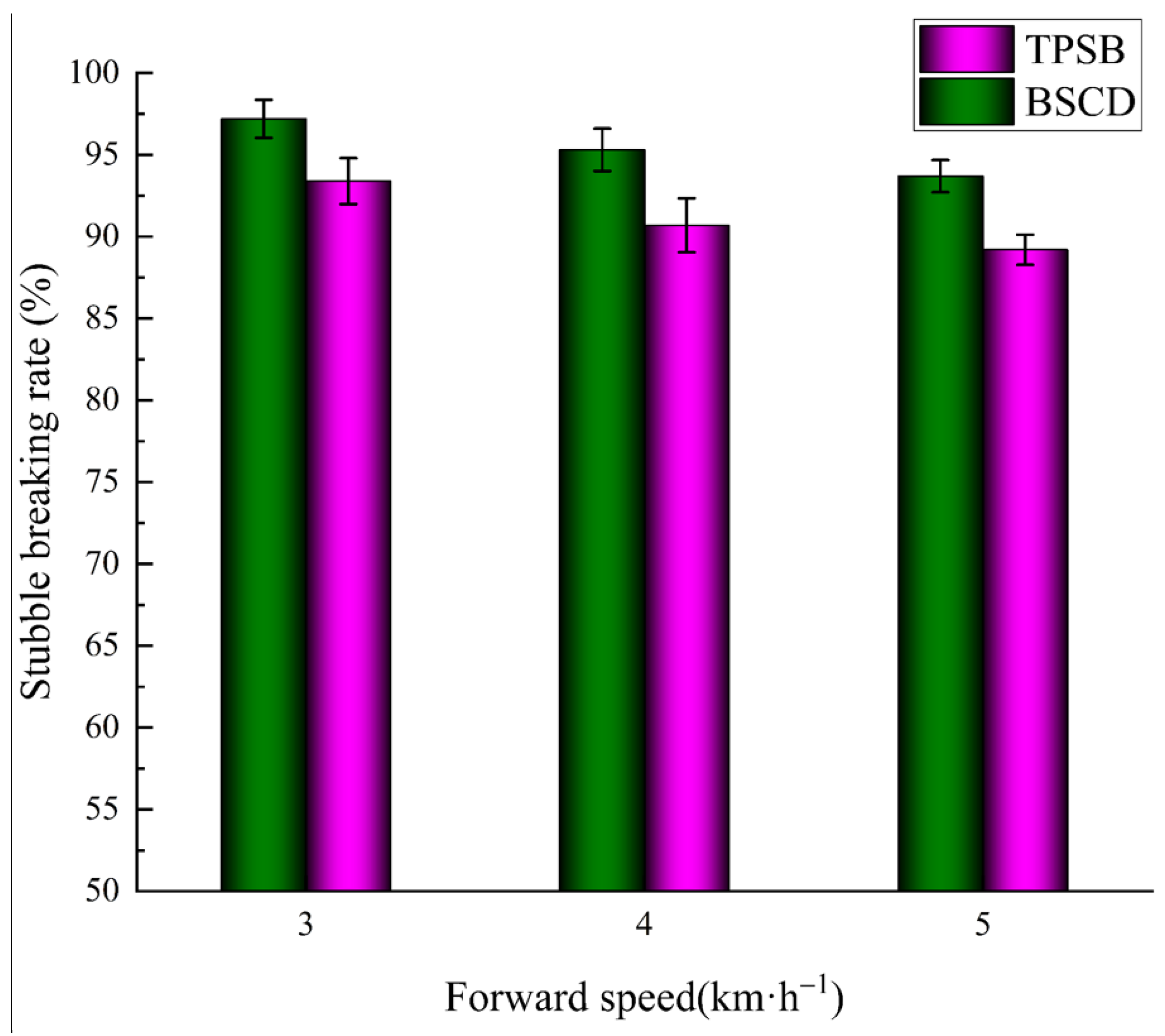
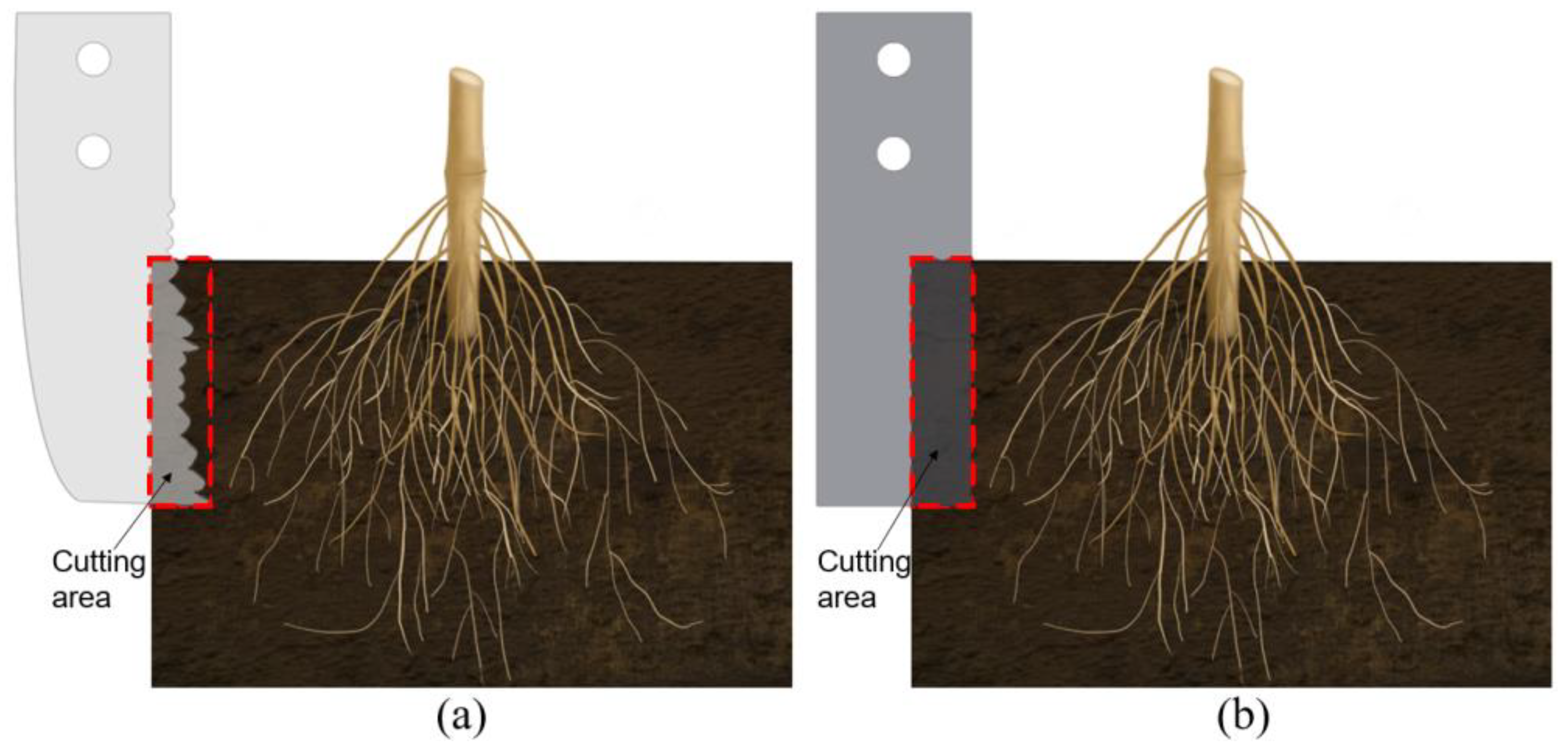

| Fit Curve 1 | Fit Curve 2 | Fit Curve 3 | Fit Curve 4 | |
|---|---|---|---|---|
| B0 | 29.80963 | 20.32147 | 25.72501 | 18.81605 |
| Standard error of B0 | 0.24873 | 0.28949 | 0.3941 | 0.62633 |
| B1 | 1.16316 | 1.1197 | 1.67476 | 1.73402 |
| Standard error of B1 | 0.12915 | 0.17707 | 0.27805 | 0.22124 |
| B2 | 0.0219 | −0.09234 | −0.11186 | −0.09646 |
| Standard error of B2 | 0.02069 | 0.03391 | 0.05962 | 0.0246 |
| B3 | −0.00488 | 0.01058 | 0.01124 | 0.00479 |
| Standard error of B3 | 0.00145 | 0.00289 | 0.00566 | 0.00123 |
| B4 | 2.373 × 10−4 | −6.02588 × 10−4 | −6.87493 × 10−4 | −1.28623 × 10−4 |
| Standard error of B4 | 5.30277 × 10−5 | 1.31047 × 10−4 | 2.85288 × 10−4 | 3.29263 × 10−5 |
| B5 | −5.67402 × 10−6 | 1.86173 × 10−5 | 2.37222 × 10−5 | 2.08392 × 10−6 |
| Standard error of B5 | 1.08574 × 10−6 | 3.45754 × 10−6 | 8.34036 × 10−6 | 5.13266 × 10−7 |
| B6 | 7.24354 × 10−8 | −3.32536 × 10−7 | −4.7649 × 10−7 | −2.09836 × 10−8 |
| Standard error of B6 | 1.25466 × 10−8 | 5.46941 × 10−8 | 1.45887 × 10−7 | 4.79828 × 10−9 |
| B7 | −4.75336 × 10−10 | 3.43393 × 10−9 | 5.52667 × 10−9 | 1.26857 × 10−10 |
| Standard error of B7 | 7.63996 × 10−11 | 5.10951 × 10−10 | 1.50449 × 10−9 | 2.64823 × 10−11 |
| B8 | 1.26393 × 10−12 | −1.90511 × 10−11 | −3.43133 × 10−11 | −4.18508 × 10−13 |
| Standard error of B8 | 1.90507 × 10−13 | 2.59721 × 10−12 | 8.4306 × 10−12 | 7.94833 × 10−14 |
| B9 | 0 | 4.39715 × 10−14 | 8.82263 × 10−14 | 5.76743 × 10−16 |
| Standard error of B9 | 0 | 5.53552 × 10−15 | 1.9786 × 10−14 | 9.99645 × 10−17 |
| R2 | 0.99921 | 0.99894 | 0.99808 | 0.99855 |
| Fit Curve 5 | Fit Curve 6 | Fit Curve 7 | |
|---|---|---|---|
| B0 | 48.024 | 111.74722 | 131.17541 |
| Standard error of B0 | 0.48739 | 1.0711 | 1.6702 |
| B1 | 1.81779 | 1.56876 | 4.07523 |
| Standard error of B1 | 0.17141 | 0.55896 | 0.52096 |
| B2 | −0.01905 | 0.11275 | −0.24141 |
| Standard error of B2 | 0.01879 | 0.09355 | 0.05035 |
| B3 | −8.47966 × 10−4 | −0.01391 | 0.01172 |
| Standard error of B3 | 9.17851 × 10−4 | 0.00682 | 0.00218 |
| B4 | 4.11696 × 10−5 | 6.51882 × 10−4 | −3.06349 × 10−4 |
| Standard error of B4 | 2.38711 × 10−5 | 2.61758 × 10−4 | 5.02728 × 10−5 |
| B5 | −6.22106 × 10−7 | −1.59409 × 10−5 | 4.47507 × 10−6 |
| Standard error of B5 | 3.60044 × 10−7 | 5.79118 × 10−6 | 6.74323 × 10−7 |
| B6 | 3.94614 × 10−9 | 2.22628 × 10−7 | −3.73378 × 10−8 |
| Standard error of B6 | 3.2496 × 10−9 | 7.65013 × 10−8 | 5.42557 × 10−9 |
| B7 | −7.48538 × 10−12 | −1.7975 × 10−9 | 1.76242 × 10−10 |
| Standard error of B7 | 1.72905 × 10−11 | 5.95384 × 10−10 | 2.58004 × 10−11 |
| B8 | −2.27969 × 10−14 | 7.83116 × 10−12 | −4.37193 × 10−13 |
| Standard error of B8 | 4.99782 × 10−14 | 2.51753 × 10−12 | 6.68139 × 10−14 |
| B9 | 8.24005 × 10−17 | −1.42764 × 10−14 | 4.41765 × 10−16 |
| Standard error of B9 | 6.04847 × 10−17 | 4.45922 × 10−15 | 7.26076 × 10−17 |
| R2 | 0.99934 | 0.99655 | 0.99923 |
| Factor | Code | Level | ||
|---|---|---|---|---|
| −1 | 0 | 1 | ||
| n | X1 | 120 | 180 | 240 |
| D | X2 | 40 | 65 | 90 |
| V | X3 | 3 | 4 | 5 |
| Number | n (rpm) | D (mm) | V (km/h) | X1 | X2 | X3 | T (N·m) | P (kW) |
|---|---|---|---|---|---|---|---|---|
| 1 | 120 | 40 | 4 | −1 | −1 | 0 | 23.47 | 0.314192 |
| 2 | 240 | 40 | 4 | 1 | −1 | 0 | 13.16 | 0.349171 |
| 3 | 120 | 90 | 4 | −1 | 1 | 0 | 50.27 | 0.695046 |
| 4 | 240 | 90 | 4 | 1 | 1 | 0 | 36.83 | 0.988208 |
| 5 | 120 | 65 | 3 | −1 | 0 | −1 | 36.54 | 0.482582 |
| 6 | 240 | 65 | 3 | 1 | 0 | −1 | 24.06 | 0.627857 |
| 7 | 120 | 65 | 5 | −1 | 0 | 1 | 44.13 | 0.601189 |
| 8 | 240 | 65 | 5 | 1 | 0 | 1 | 30.95 | 0.823296 |
| 9 | 180 | 40 | 3 | 0 | −1 | −1 | 16.36 | 0.321051 |
| 10 | 180 | 90 | 3 | 0 | 1 | −1 | 38.21 | 0.763479 |
| 11 | 180 | 40 | 5 | 0 | −1 | 1 | 21.93 | 0.440974 |
| 12 | 180 | 90 | 5 | 0 | 1 | 1 | 47.45 | 0.977871 |
| 13 | 180 | 65 | 4 | 0 | 0 | 0 | 34.19 | 0.677952 |
| 14 | 180 | 65 | 4 | 0 | 0 | 0 | 32.69 | 0.65069 |
| 15 | 180 | 65 | 4 | 0 | 0 | 0 | 33.5 | 0.665091 |
| 16 | 180 | 65 | 4 | 0 | 0 | 0 | 33.41 | 0.663805 |
| 17 | 180 | 65 | 4 | 0 | 0 | 0 | 33.23 | 0.659791 |
| Source of Variation | Sum of Squares | Degree of Freedom | Mean Squares | F | p |
|---|---|---|---|---|---|
| Model | 1645.79 | 9 | 182.87 | 451.04 | <0.0001 |
| X1 | 305.17 | 1 | 305.17 | 752.71 | <0.0001 |
| X2 | 1196.58 | 1 | 1196.58 | 2951.41 | <0.0001 |
| X3 | 107.24 | 1 | 107.24 | 264.51 | <0.0001 |
| X1 X2 | 2.45 | 1 | 2.45 | 6.04 | 0.0436 |
| X1 X3 | 0.1225 | 1 | 0.1225 | 0.3021 | 0.5996 |
| X2 X3 | 3.37 | 1 | 3.37 | 8.31 | 0.0236 |
| X12 | 0.2237 | 1 | 0.2237 | 0.5518 | 0.4818 |
| X22 | 30.74 | 1 | 30.74 | 75.82 | <0.0001 |
| X32 | 0.3432 | 1 | 0.3432 | 0.8465 | 0.3881 |
| Residual | 2.84 | 7 | 0.4054 | ||
| Lack of fit | 1.67 | 3 | 0.5570 | 1.91 | 0.2696 |
| Pure error | 1.17 | 4 | 0.2918 | ||
| Cor.Total | 1648.63 | 16 |
| Source of Variation | Sum of Squares | Degree of Freedom | Mean Squares | F | p |
|---|---|---|---|---|---|
| Model | 0.6462 | 9 | 0.0718 | 599.18 | <0.0001 |
| X1 | 0.0605 | 1 | 0.0605 | 504.60 | <0.0001 |
| X2 | 0.4996 | 1 | 0.4996 | 4169.11 | <0.0001 |
| X3 | 0.0525 | 1 | 0.0525 | 438.49 | <0.0001 |
| X1 X2 | 0.0167 | 1 | 0.0167 | 139.06 | <0.0001 |
| X1 X3 | 0.0015 | 1 | 0.0015 | 12.32 | 0.0099 |
| X2 X3 | 0.0022 | 1 | 0.0022 | 18.62 | 0.0035 |
| X12 | 0.0050 | 1 | 0.0050 | 41.73 | 0.0003 |
| X22 | 0.0076 | 1 | 0.0076 | 63.02 | <0.0001 |
| X32 | 0.0001 | 1 | 0.0001 | 0.7852 | 0.4050 |
| Residual | 0.0008 | 7 | 0.0001 | ||
| Lack of fit | 0.0004 | 3 | 0.0001 | 1.54 | 0.3346 |
| Pure error | 0.0004 | 4 | 0.0001 | ||
| Cor.Total | 0.6471 | 16 |
Disclaimer/Publisher’s Note: The statements, opinions and data contained in all publications are solely those of the individual author(s) and contributor(s) and not of MDPI and/or the editor(s). MDPI and/or the editor(s) disclaim responsibility for any injury to people or property resulting from any ideas, methods, instructions or products referred to in the content. |
© 2023 by the authors. Licensee MDPI, Basel, Switzerland. This article is an open access article distributed under the terms and conditions of the Creative Commons Attribution (CC BY) license (https://creativecommons.org/licenses/by/4.0/).
Share and Cite
Qi, H.; Ma, Z.; Xu, Z.; Wang, S.; Ma, Y.; Wu, S.; Guo, M. The Design and Experimental Validation of a Biomimetic Stubble-Cutting Device Inspired by a Leaf-Cutting Ant’s Mandibles. Biomimetics 2023, 8, 555. https://doi.org/10.3390/biomimetics8070555
Qi H, Ma Z, Xu Z, Wang S, Ma Y, Wu S, Guo M. The Design and Experimental Validation of a Biomimetic Stubble-Cutting Device Inspired by a Leaf-Cutting Ant’s Mandibles. Biomimetics. 2023; 8(7):555. https://doi.org/10.3390/biomimetics8070555
Chicago/Turabian StyleQi, Hongyan, Zichao Ma, Zihe Xu, Shuo Wang, Yunhai Ma, Siyang Wu, and Mingzhuo Guo. 2023. "The Design and Experimental Validation of a Biomimetic Stubble-Cutting Device Inspired by a Leaf-Cutting Ant’s Mandibles" Biomimetics 8, no. 7: 555. https://doi.org/10.3390/biomimetics8070555
APA StyleQi, H., Ma, Z., Xu, Z., Wang, S., Ma, Y., Wu, S., & Guo, M. (2023). The Design and Experimental Validation of a Biomimetic Stubble-Cutting Device Inspired by a Leaf-Cutting Ant’s Mandibles. Biomimetics, 8(7), 555. https://doi.org/10.3390/biomimetics8070555








